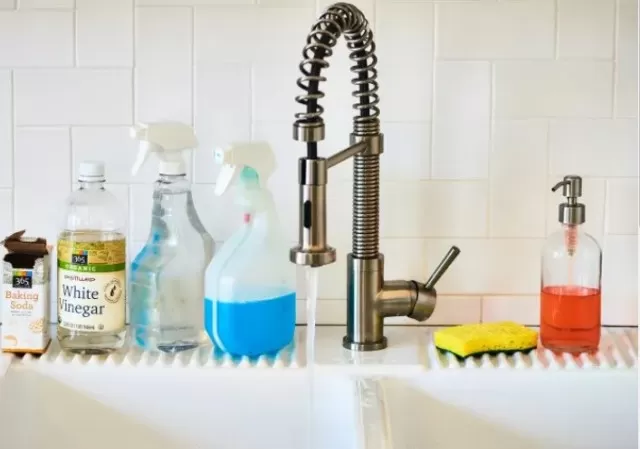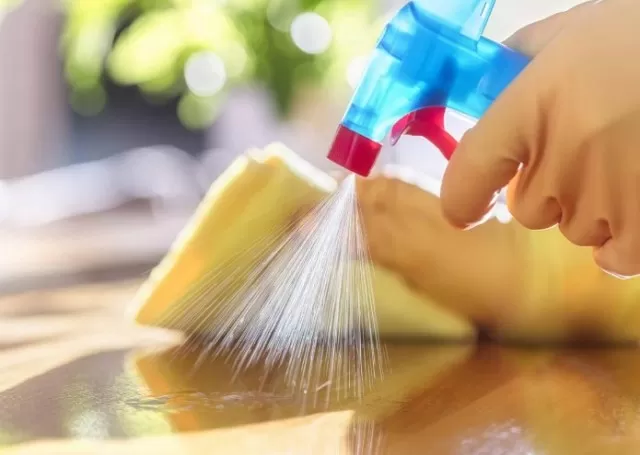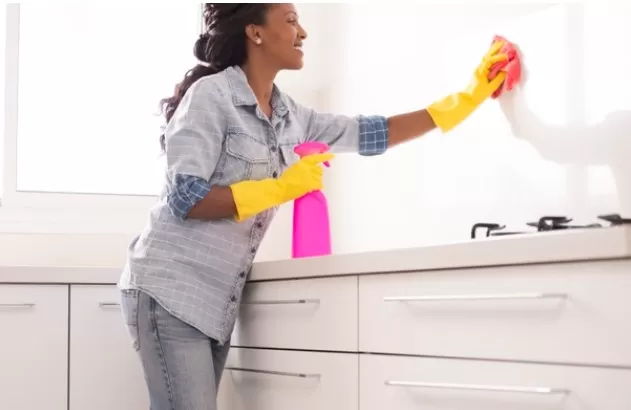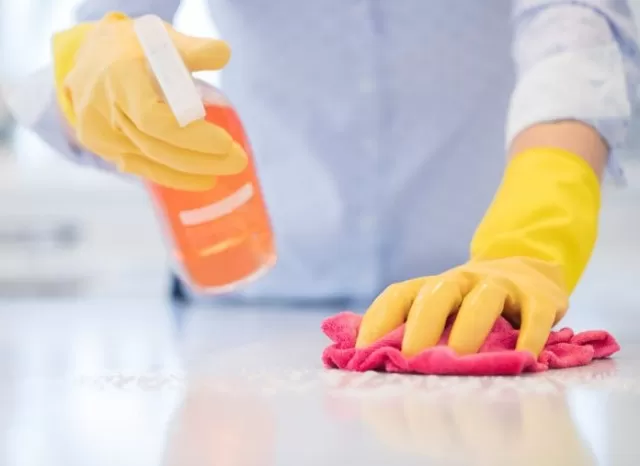Cleaning up a living space can vary in meaning depending on the individual. For a child, it may involve picking up scattered toys, while in the kitchen, it could refer to washing dishes and storing leftovers.
However, there are specific definitions for cleaning, sanitizing, and disinfecting surfaces in homes, schools, and public places, as outlined by the Centers for Disease Control and Prevention (CDC). These definitions help determine the level of microbial contamination remaining on a surface after treatment.
For homeowners, understanding these terms is crucial when reading product labels and selecting appropriate cleaning agents. It becomes particularly important when someone in the household is ill, has been in contact with an ill person, or has a compromised immune system. This knowledge enables you to ensure the proper level of sanitation required for a safe and healthy environment.
The Essence of Cleanliness: Defining the Art of Cleaning

Cleaning involves the systematic elimination of visible debris, dirt, and dust while organizing a space.
This process typically entails using soap or detergent, along with water, to rid surfaces of soil and germs through chemical, mechanical, and thermal actions—employing cleaners, scrubbing, and adjusting water temperature as necessary.
While cleaning may not always eliminate all bacteria and germs, it plays a vital role in reducing their presence and mitigating the risk of infection transmission.
By effectively removing these contaminants, cleaning contributes to creating a healthier and safer environment.
Safeguarding Health: Unveiling the Meaning of Sanitizing

Sanitizing, as indicated by product claims, signifies the process of diminishing the presence of potentially harmful germs on surfaces to comply with public health standards or regulations.
Rather than eliminating them entirely, sanitizing aims to reduce the quantity and proliferation of bacteria, viruses, and fungi. 1.
The significance of sanitizing becomes particularly pronounced in food preparation areas, where the presence of germs and fungi can pose a risk of foodborne illnesses.
By implementing proper sanitization practices, the likelihood of such illnesses can be minimized, promoting a safer food environment.
The Power of Purity: Unveiling the Definition of Disinfecting

Disinfecting involves the eradication of microscopic organisms, such as bacteria, viruses, and fungi, from surfaces.
This process typically employs EPA-approved chemicals that effectively kill these organisms and prevent their further spread. Alternatively, UV-C germicidal short wavelength, ultraviolet light can be utilized to disrupt the DNA of bacteria and germs, rendering them incapable of causing harm or reproducing.
Notably, this UV-C light technology is employed in hospital surgical suites to combat resilient superbugs. 2.
It is important to note that disinfection may not necessarily eliminate visible dirt and debris from surfaces.
For optimal effectiveness, it is recommended to perform basic cleaning prior to disinfection. By combining these two practices, the desired level of cleanliness and safety can be achieved.
Cleaning, Sanitizing, or Disinfecting: Choosing the Right Approach for Your Needs
Maintaining a clean and healthy environment is essential for the well-being of individuals and the prevention of illness.
When it comes to cleaning, sanitizing, and disinfecting, understanding the differences and knowing when to apply each method is crucial.
Cleaning is the fundamental process of removing visible debris, dirt, and dust from surfaces.
It involves using soap or detergent and water to eliminate soil and germs through chemical, mechanical, and thermal actions. While cleaning may not eliminate all bacteria and germs, it significantly reduces their presence, lowering the risk of spreading infection.
Sanitizing, on the other hand, focuses on reducing the number and growth of harmful bacteria, viruses, and fungi.
It aims to meet public health standards and requirements by using specific products or methods that effectively decrease the presence of these microorganisms. Sanitizing is particularly important in areas like food preparation spaces, where germs can lead to foodborne illnesses.
Disinfecting goes a step further by killing microscopic organisms on surfaces.
EPA-approved chemicals or UV-C germicidal light technology are commonly used to eliminate bacteria, viruses, and fungi, rendering them unable to harm or reproduce. Disinfection is crucial in situations where there is a need to prevent the spread of contagious diseases or when someone in the household is ill.
It is important to understand that each approach serves a distinct purpose and should be chosen based on specific needs.
Routine cleaning helps maintain order, reduces the growth of harmful organisms, and protects your home and belongings. Sanitizing is essential for maintaining health and hygiene, especially on frequently touched surfaces.
Disinfecting should be employed when there is a need to eliminate microorganisms, particularly during illness or in high-risk situations.
By adopting a comprehensive approach to cleaning, sanitizing, and disinfecting, you can create a safe and healthy environment for yourself and your loved ones.
Remember to follow product instructions and use appropriate methods to ensure the effectiveness of these practices.
Cleaning, sanitizing, and disinfecting are essential tasks to maintain a clean and healthy environment

Start with cleaning
Before sanitizing or disinfecting, remove visible dirt, debris, and dust by cleaning surfaces with soap or detergent and water.
This step helps prepare the surface for further treatment.
Choose the right products
Use appropriate cleaning, sanitizing, and disinfecting products based on the specific needs and desired level of microbial reduction.
Look for EPA-approved disinfectants and follow the instructions for proper use.
Follow proper techniques
Use proper techniques for cleaning, such as scrubbing, wiping, or vacuuming, to ensure thorough coverage and removal of contaminants.
Pay attention to commonly touched surfaces and areas prone to contamination.
Focus on high-touch areas
Give extra attention to frequently touched surfaces like doorknobs, light switches, countertops, and electronic devices.
These areas can harbor a higher concentration of germs and should be regularly cleaned, sanitized, or disinfected.
Allow sufficient contact time
When using sanitizers or disinfectants, ensure they remain on the surface for the recommended contact time specified on the product label.
This allows the product to effectively kill germs and achieve the desired level of sanitation.
Use proper protective measures
Wear gloves and other protective gear when handling cleaning or disinfecting products to protect your skin and prevent cross-contamination.
Follow safety guidelines provided by the product manufacturer.
Ventilate the area
When using disinfectants, ensure proper ventilation in the room to allow fresh air circulation.
This helps remove any chemical fumes and ensures a safe environment.
Regularly clean and disinfect shared items: Pay extra attention to shared items, such as kitchen utensils, bathroom fixtures, and electronics, by cleaning and disinfecting them regularly.
This helps prevent the spread of germs among household members.
Establish a cleaning routine
Develop a regular cleaning schedule to maintain cleanliness and hygiene in your home or workspace.
Consistency is key in preventing the buildup of dirt and germs.
Stay informed
Keep up-to-date with the latest guidelines and recommendations from reputable sources, such as the CDC or local health authorities, to ensure you are implementing the most effective cleaning, sanitizing, and disinfecting practices.
By following these tips, you can effectively clean, sanitize, and disinfect your surroundings, promoting a healthy and safe environment for yourself and those around you.
*The information is for reference only.